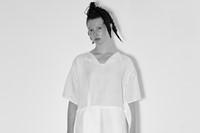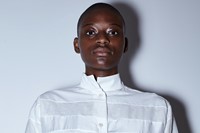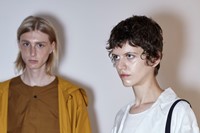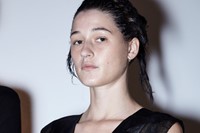In an unfiltered conversation which took place prior to the designer’s London Fashion Week Show, Phoebe English tells us why the fashion industry must face up to the climate crisis together
The invitation to view Phoebe English’s latest collection – shown this past Sunday in the basement of a Marylebone restaurant – called on her friends to join her at “a presentation of attempts at sustainability solutions”. It was a polite understatement: for the past three seasons, English has steadfastly been rebuilding her entire eponymous label from the ground up, reassessing each and every process that it takes to get her collections from idea to shop floor. This presentation was the spoils. “If you’re contributing to one of the most damaging industries on the entire planet,” she said prior to the show, “you can’t just continue the way you’ve been going.”
The Spring/Summer 2020 collection – now encompassing mens- and womenswear in a single show, one of her first decisions she took when restructuring the label – was presented amid various moodboards, each pinned with the sustainable fabric samples used to make each garment. (An extensive list was also handed to attendees of the materials, from IVN-certified organic cotton and re-approapriated deadstock fabric, to biodegradable buttons made from casein, a naturally occuring protein in milk.) It lent the graceful collection – styled by Another Man fashion director Ellie Grace Cumming and bearing English’s hallmark of relaxed, workwear-inflected silhouettes and muted palette – a renewed urgency. One dress saw leftover care labels, used by English in her first collections, trapped within the organza. She wanted to show how far she had come: “That piece is like a time capsule. It has fabric and washing instructions we would never use now. I think this is the kind of thing that historians will look back on and be like: ‘what were they doing?’”
A week before the show, I spoke with English in her Deptford studio. She is animated and urgent: when I arrive, she shows me the recycled cardboard hangers and paper wrapping she now sends her garments out in (plastic is all but eradicated from the studio); the bags filled with fabric offcuts, which she will eventually find a way to make into clothing. She talks about illuminating conversations she has had with Extinction Rebellion and Boycott Fashion, or with other London-based designers, who she speaks to via a 25-strong WhatsApp group (“We realised that a lot of other people wanted to know about what we were doing, it’s kind of become a place where people can ask questions”). Her dedication is resolute.
Here, in part of an unfiltered conversation with the designer, English tells us why the fashion industry must unite to face the climate crisis now – or risk dying out forever.
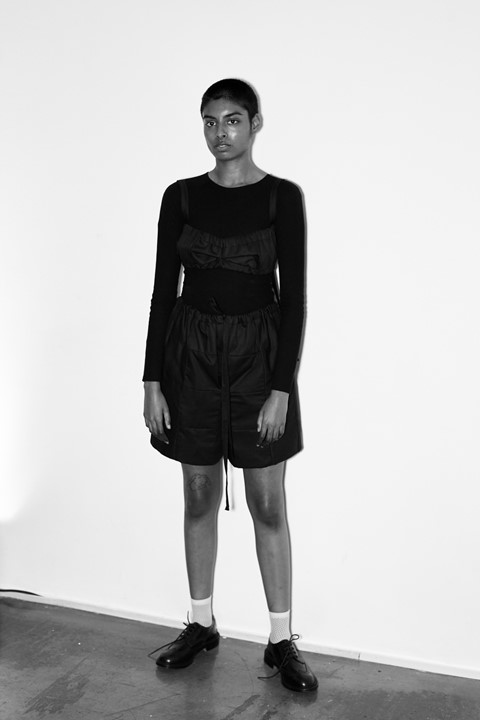
“We’re living in quite a strange, daunting time – the statistics about the fashion industry are absolutely horrendous. Once you know them, you can’t unknow them. So, I’m trying to use that energy of extreme fear to propel solution-based design. This new collection is about disinheriting the things that I’ve inherited and really carefully analysing what we’re doing, and inheriting new ideas and new processes.
“Those problems are within our systems. So any systems that we have control over – whether that’s just what we have in our kitchen or what we use in our business, if we have any systems that we have direct control over, we need to alter them quickly, drastically, and right now. I think for me that realisation came about one summer ago, where I realised that I had a system – the Phoebe English business – that I was directly in control of, that I could actually change to be a more positive and less impactful system. But I also realised it was something I couldn’t do if I carried on at the same pace I had been going.
“Is it luxury if it’s made of fabric that’s filled a river with pollution? Is it luxury if it’s destroyed whole ecosystems in order to be grown?”
“It was very frightening to put into practice – obviously, you don’t want to drop off or drop out or be irrelevant, or have people forget about you, or lose your customer base. But it was something that we had to do. We had to slow down. If you’re contributing to one of the most damaging industries on the entire planet, if you’re a part of that system, and aware of the damage you’re making, and with the current knowledge of what’s happening to the planet, you can’t continue the way you’ve been going. I had to really stop, re-educate myself, re-research how we were working, doing that with the whole team and trying to alter the business as much as we can.
“But we did have to stop; so we didn’t do February men’s fashion week, or June. We’re showing mens- and womenswear together so we have a longer time to develop and research – if we are making clothes, we’re making them to the best of our abilities with the best materials and in the least impactful way. That’s the idea and that’s what I think luxury should be. We are a luxury fashion label, it’s not a product that everyone can afford. It’s a special product that you might save up to have, and you might just have one of those things in your life – it’s not about selling masses of clothes. That’s not what we’re doing here. If that is what we were doing, is it luxury? Is it luxury if it’s made of fabric that’s filled a river with pollution? Is it luxury if it’s destroyed whole ecosystems in order to be grown? What does that actually constitute if it’s caused so much damage? Is that still a nice thing that you want to spend a lot of money on?
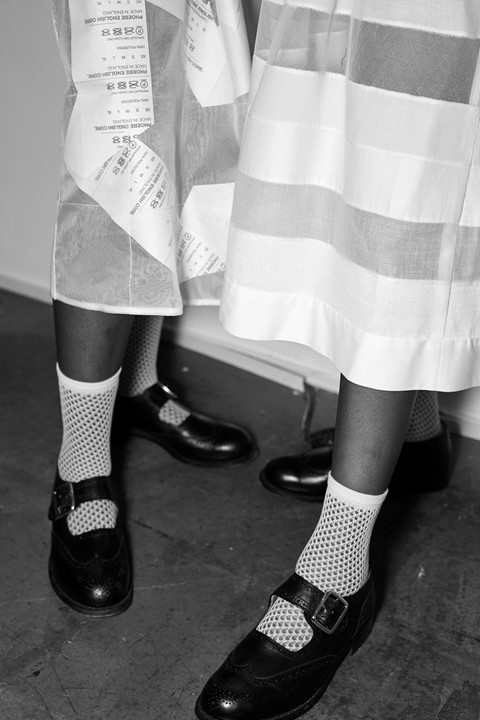
“Now, sustainability has become part of the way we design. However far you travel with a garment, it’s always come from a field, or the earth under the field. No matter how removed from those natural elements it becomes, all of it and all its components have at some point originated from both those places. We’re trying as hard as we can, and I’m absolutely not saying we’ve reached a perfect solution. But what we are doing is trying as many solutions as we can to make sure we know where everything is coming from. After that, it’s about continuing to try and also to talk to people and educate them.
“That conversation is important. We’ve had a food revolution. We had this revolution where there were those massive realisations about intensive farming and non-organic farming practices and how that affects people. We haven’t had that so much with fashion and I feel like that’s where we are now. It’s beginning to seep into the general consciousness and that’s where it will really start to make a difference. We are running out of resources very, very fast as it gets hotter and hotter. Is virgin cotton actually going to be more luxurious than cashmere because of the amount of water it takes to make?
“When there’s an emergency, you don’t separate, you come together. As designers, as consumers, and as individuals, that’s what we need to do”
“So we’re really looking at a changing landscape – how does design evolve to that? How can we use what we’re doing as something that’s potentially useful to resources? We’re trying to eradicate any virgin resources in the collections unless they’re certified. We’re making the largest proportion of the raw materials we’re using in the collection reclaimed materials. We’re using excess waste materials to make the majority of our production and our collection.
“This latest show is an opportunity for us to share everything we are doing with the general public and the guests that come. Hopefully, we’ll be able to share some solutions to some pretty big problems. Or some ideas for solutions. When I first started the business eight years ago, there was very much a mentality that you’re vying for the same business as other designers – other businesses are your competitors. But I think we need to eradicate that type of thinking and start sharing how we’re working because we’re living in a vastly different time in terms of the public realisation of what’s happening, what is actually happening, what we can do as individuals and business owners. There are so many things that we can be doing, but we need to come together, and all the different areas of the sector – styling, publishing, designing, all of it.
“When there’s an emergency, you don’t separate, you come together. As designers, as consumers, and as individuals, that’s what we need to do. Then we can move forward.”

